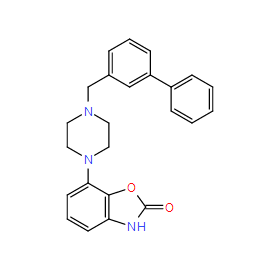| Cas No.: | 350992-10-8 |
| SMILES: | C1CN(CCN1CC2=CC=CC(=C2)C3=CC=CC=C3)C4=CC=CC5=C4OC(=O)N5 |
| Formula: | C24H23N3O2 |
| M.Wt: | 385.46 |
| Purity: | >98% |
| Sotrage: | 2 years -20°C Powder, 2 weeks 4°C in DMSO, 6 months -80°C in DMSO |
| Description: | Bifeprunox is a potent dopamine D2-like and 5-HT1A receptor partial agonist with pKis of 7.19 and 8.83 for cortex 5-HT1A and striatum D2, and a pEC50 of 6.37 for hippocampus 5-HT1A, respectively. Bifeprunox is an antipsychotic for the research of schizophrenia[1][2]. |
| Target: | 5-HT1A Receptor:7.19 (pKi, cortex) D2 Receptor:8.83 (pKi, striatum) 5-HT1A Receptor:6.37 (pEC50, hippocampus) |
| In Vivo: | Bifeprunox (0.001-2.5 mg/kg) reduces marble burying in mice[2]. Bifeprunox (4-250 μg/kg) influences nicotine-seeking behaviour in response to drug-associated stimuli in rats[3]. Animal Model: Male NMRI mice (weighing 20-22 g)[2] Dosage: 0.001, 0.0025, 0.01, 0.04, 0.16, 0.63, and 2.5 mg/kg Administration: I.p. Result: Reduced marble burying. Potently active from 0.0025 mg/kg. Animal Model: Naïve male Wistar rats (weighing 250-275 g)[3] Dosage: 4, 16, 64 and 250 μg/kg Administration: Injected s.c. 30 minutes before testing Result: 4-16 μg/kg dose-dependently attenuated the responsereinstating effects of nicotine-associated cues. Higher doses (64-250 μg/kg, s.c.) reduced spontaneous locomotor activity and suppressed operant responding induced by sucrose-associated cues and by the primary reinforcing properties of nicotine or sucrose. |
| In Vitro: | Bifeprunox has a pKi of 8 at h5-HT1A receptors, with an Emax of 70%[1]. |
| References: | [1]. Newman-Tancredi A, et al. Novel antipsychotics activate recombinant human and native rat serotonin 5-HT1A receptors: affinity, efficacy and potential implications for treatment of schizophrenia. Int J Neuropsychopharmacol. 2005 Sep;8(3):341-56. [2]. Bruins Slot LA, et al. Effects of antipsychotics and reference monoaminergic ligands on marble burying behavior in mice. Behav Pharmacol. 2008 Mar;19(2):145-52. [3]. Di Clemente A, et al. Bifeprunox: a partial agonist at dopamine D2 and serotonin 1A receptors, influences nicotine-seeking behaviour in response to drug-associated stimuli in rats. Addict Biol. 2012 Mar;17(2):274-86. |

 To enhance service speed and avoid tariff delays, we've opened a US warehouse. All US orders ship directly from our US facility.
To enhance service speed and avoid tariff delays, we've opened a US warehouse. All US orders ship directly from our US facility.




















